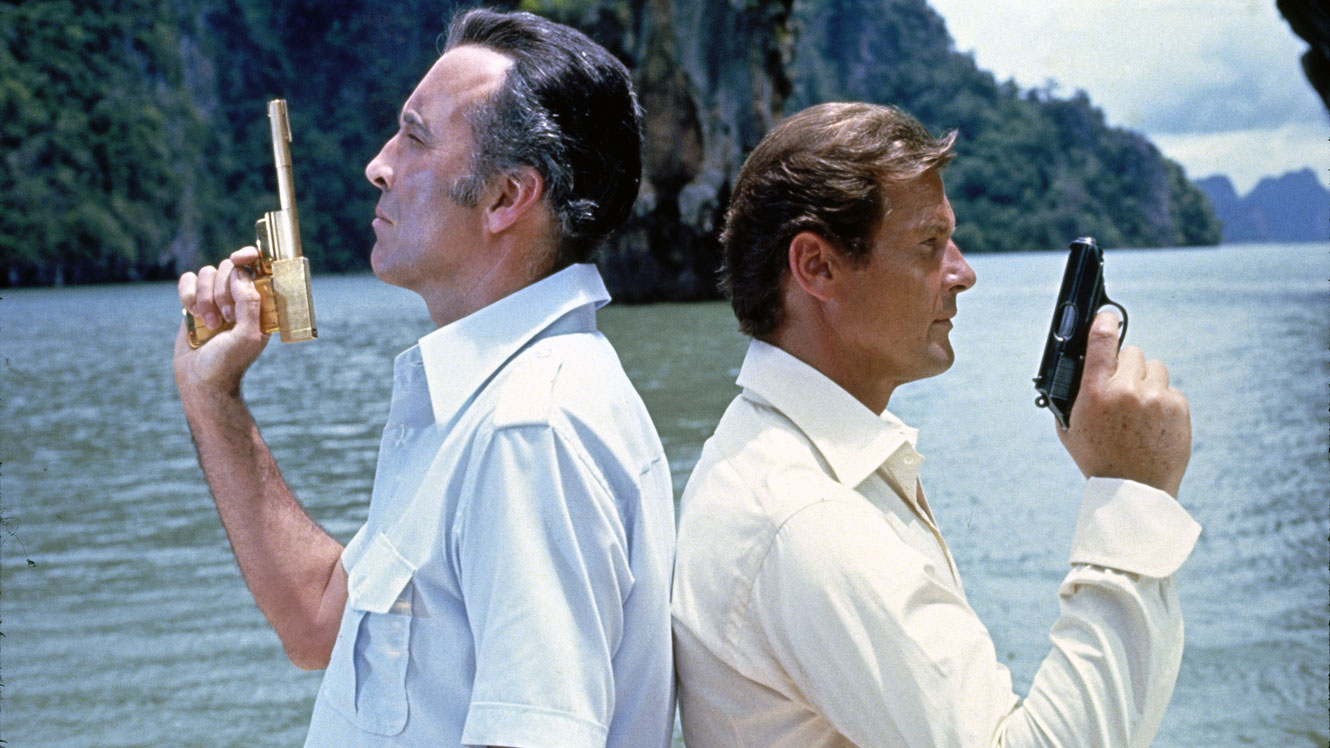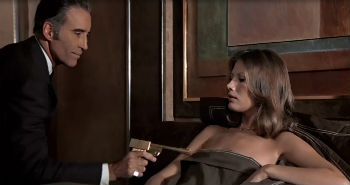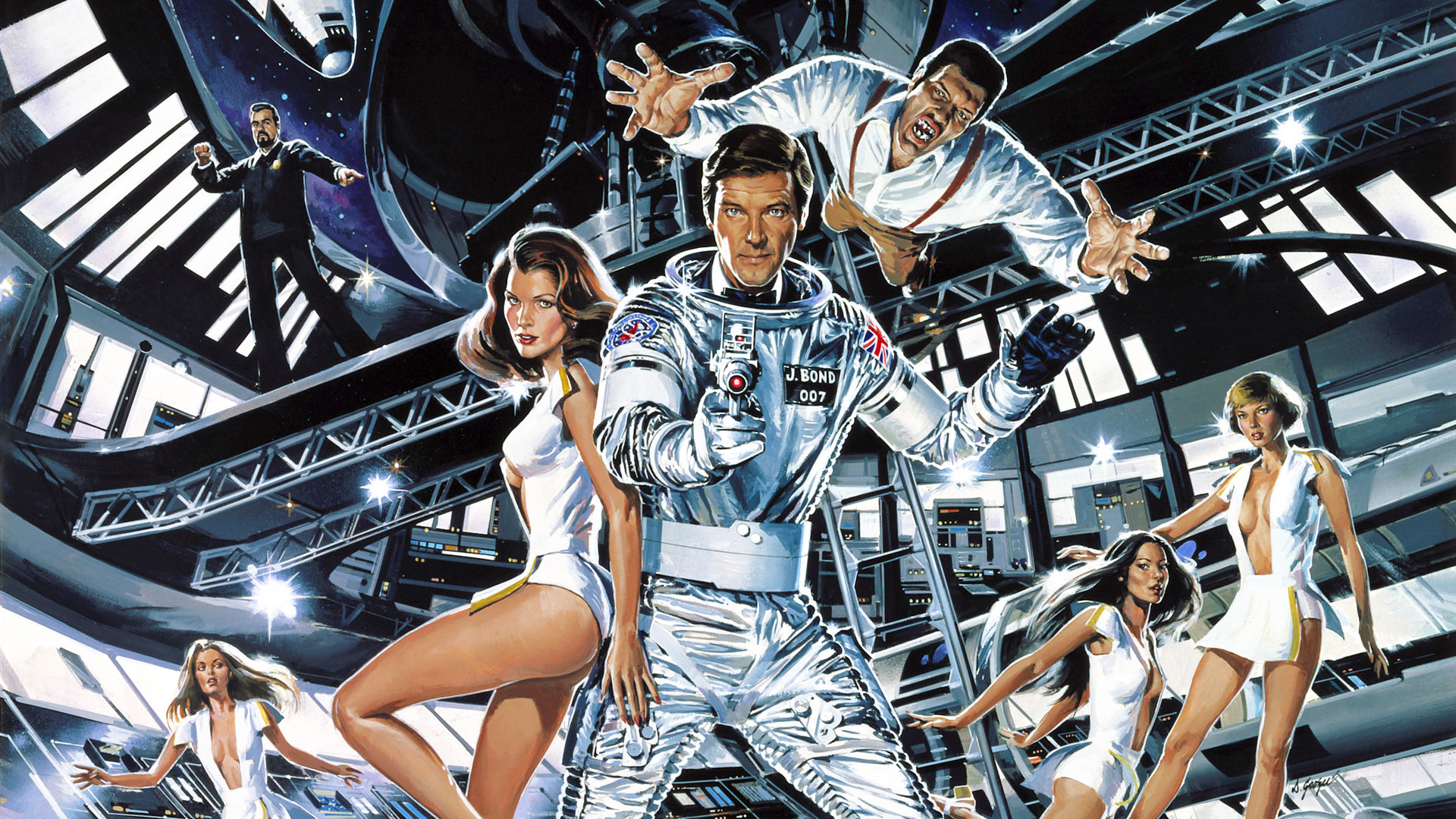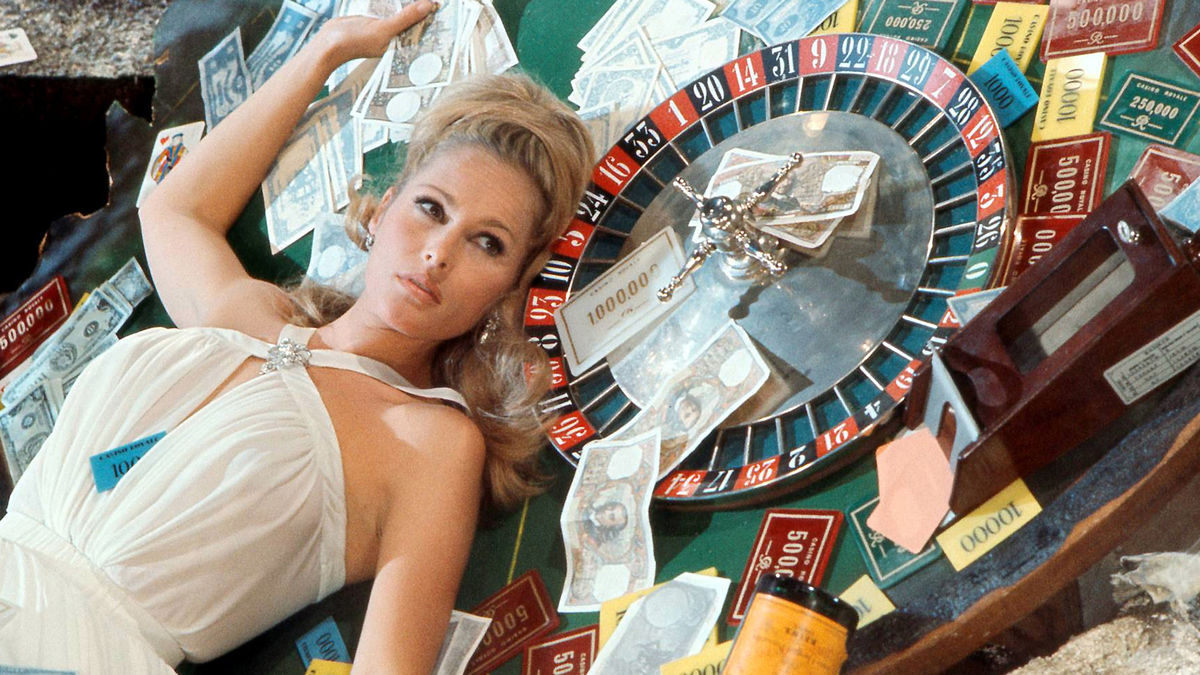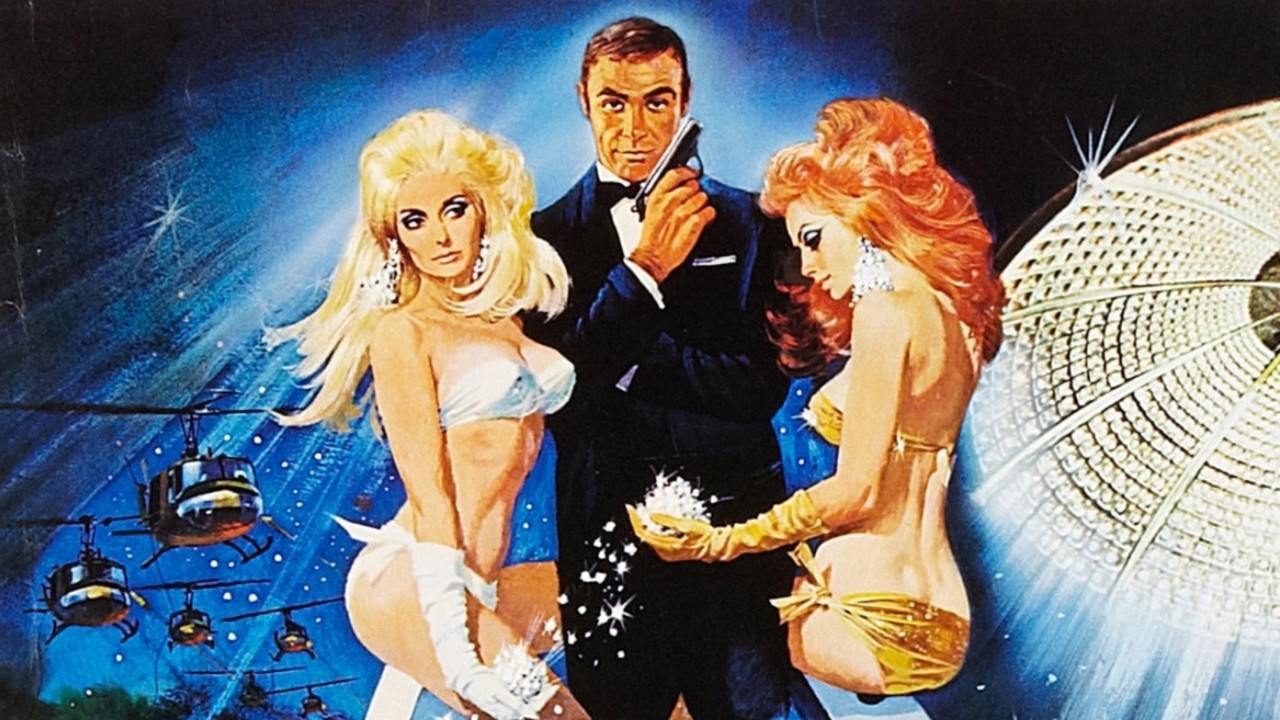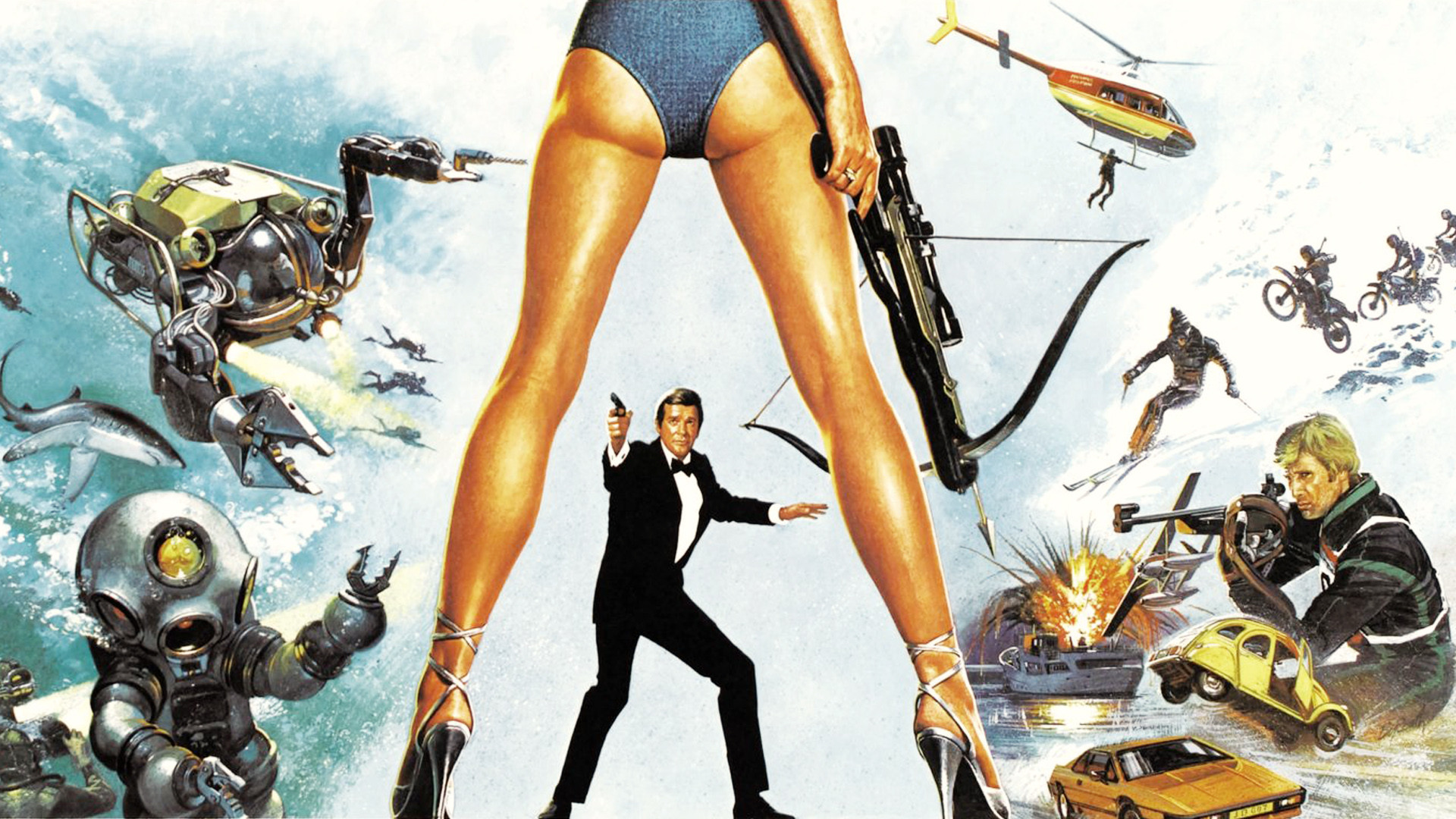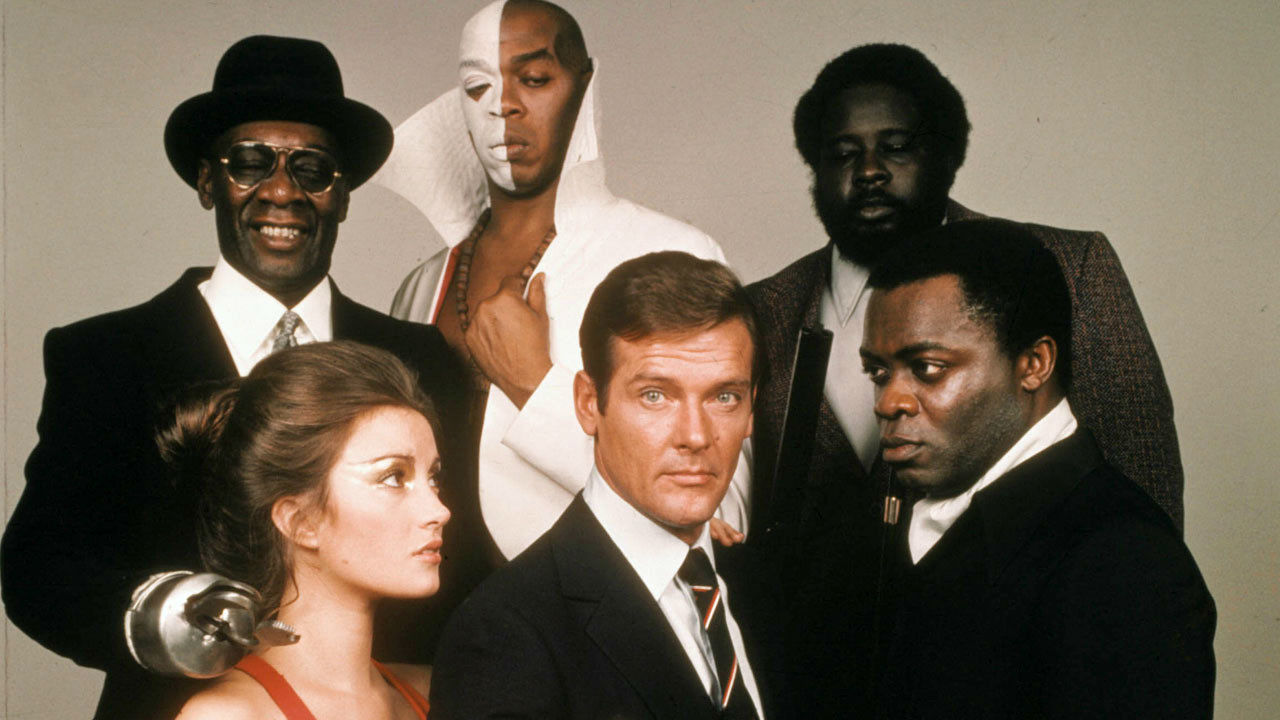The Man with the Golden Gun (1974, Dir. Guy Hamilton):
‘FRANCISCO (PACO) “PISTOLS” SCARAMANGA’: Known in his territory as “the Man with the Golden Gun” – a reference to his main weapon which is a gold-plated, long-barrelled, single-action Colt .45. He uses special bullets with a heavy, soft (24 ct) gold core jacketed with silver and cross-cut at the tip, on the dum-dum principle, for maximum wounding effect. Himself loads and artifices this ammunition. Is responsible for the death of 267 (British Guiana), 398 (Trinidad), 943 (Jamaica), and 768 and 742 (Havana).
‘DESCRIPTION: Age about 35. Height 6 ft. 3 in. Slim and fit. Eyes, light brown. Hair reddish in a crew cut. Long sideburns. Gaunt, sombre face with thin “pencil” moustache, brownish. Ears very flat to the head. Ambidextrous. Hands very large and powerful and immaculately manicured. Distinguishing marks: a third nipple about two inches below his left breast. (N.B. in Voodoo and allied local cults this is considered a sign of invulnerability and great sexual prowess.) Is an insatiable but indiscriminate womanizer who invariably has sexual intercourse before a killing in the belief that it improves his “eye.” (N.B. a belief shared by many professional lawn tennis players, golfers, gun and rifle marksmen and others.)’
— Ian Fleming, The Man with the Golden Gun
Energy — or more precisely the lack of it — defines The Man with the Golden Gun. At the time of the film’s release in 1974, the mid-seventies cultural hangover had taken hold. Out were the sparkly Hollywood blockbusters of yesteryear, and even the indie cinema heroics of Easy Rider were fading fast. Watergate and cynicism were dominant, topped off with long lines at the gas station. With the austerity of an energy crisis gripping the world, how would the excesses of James Bond fit in?
Not very well, as it turned out. Golden Gun finds the Bond franchise running short on fuel and inspiration. Not that one can find much inspiration from Fleming’s The Man with the Golden Gun; the author died before he could polish it up, and save for a bravura opening sequence in which a brainwashed Bond attempts to assassinate M, the story is the thinnest of the Bond series (find bad guy, kill bad guy without much fanfare, the end). Still, producers Albert Broccoli and Harry Saltzman had to be confident at the outset — fresh from the surprising box office success of Live and Let Die and with Roger Moore established as the new 007, a quick follow-up seemed wise. Veteran director Guy Hamilton was again at the controls, there would be exotic locales galore (Thailand, Macau and Hong Kong), and screenwriter Tom Mankiewicz had hit on a seemingly bulletproof concept: pit James Bond against the greatest assassin in the world, Francisco Scaramanga, in a showdown modeled on Alan Ladd’s duel versus Jack Palance in Shane. How could it miss?
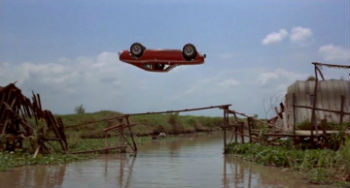 While The Man with the Golden Gun doesn’t miss completely — call it a flesh wound rather than a shot to the heart — tonally it’s one of the messier Bonds. The storytelling is straightforward if not necessarily gripping in the early going, as Bond is put on the trail of Scaramanga thanks to a golden bullet engraved with “007” delivered straight to MI-6 HQ. His quest leads him to a close encounter with Scaramanga’s bullet-maker, capped with a rifle pointed at the poor gentleman’s private parts (“Speak or forever hold your piece”), then to Scaramanga’s kept woman Andrea (icy but fragile Maud Adams), which concludes with the unlikely sight of Roger Moore slapping a woman around and nearly breaking her arm. Complications ensue when it’s discovered that Scaramanga possesses the stolen Solex Agitator, a revolutionary power cell that could end the energy crisis. So far, so intriguing. But then the clownish moments begin to pile up: a throw-down with two Sumo wrestlers in which Bond gives his opponent the mother of all wedgies; a poorly choreographed kung fu tussle between Bond and a martial arts black belt that clearly wants to cash in on the Hong Kong chop-socky craze like Live and Let Die cashed in on blaxploitation, followed up with an even more ridiculous bit in which the teenage nieces of Bond’s buddy Lieutenant Hip (Soon-Tek Oh) take out an entire dojo; the unwelcome return of hick sheriff J.W. Pepper (Clifton James), who happens to be around when Bond hijacks an AMC Hornet (bleah) to chase Scaramanga. Even the moments of spectacle are undercut by cheese, like that famous 360-degree jump with the Hornet, scored with a slide whistle.
While The Man with the Golden Gun doesn’t miss completely — call it a flesh wound rather than a shot to the heart — tonally it’s one of the messier Bonds. The storytelling is straightforward if not necessarily gripping in the early going, as Bond is put on the trail of Scaramanga thanks to a golden bullet engraved with “007” delivered straight to MI-6 HQ. His quest leads him to a close encounter with Scaramanga’s bullet-maker, capped with a rifle pointed at the poor gentleman’s private parts (“Speak or forever hold your piece”), then to Scaramanga’s kept woman Andrea (icy but fragile Maud Adams), which concludes with the unlikely sight of Roger Moore slapping a woman around and nearly breaking her arm. Complications ensue when it’s discovered that Scaramanga possesses the stolen Solex Agitator, a revolutionary power cell that could end the energy crisis. So far, so intriguing. But then the clownish moments begin to pile up: a throw-down with two Sumo wrestlers in which Bond gives his opponent the mother of all wedgies; a poorly choreographed kung fu tussle between Bond and a martial arts black belt that clearly wants to cash in on the Hong Kong chop-socky craze like Live and Let Die cashed in on blaxploitation, followed up with an even more ridiculous bit in which the teenage nieces of Bond’s buddy Lieutenant Hip (Soon-Tek Oh) take out an entire dojo; the unwelcome return of hick sheriff J.W. Pepper (Clifton James), who happens to be around when Bond hijacks an AMC Hornet (bleah) to chase Scaramanga. Even the moments of spectacle are undercut by cheese, like that famous 360-degree jump with the Hornet, scored with a slide whistle.
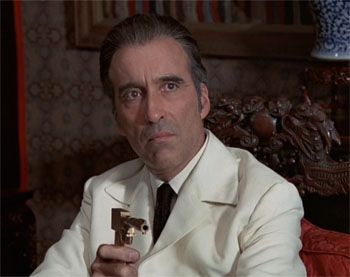 The film does have scattered moments of inspiration, chief among them the casting of the commanding Christopher Lee (incidentally, a distant cousin of Ian Fleming) as Scaramanga. Although he’s underused, he’s certainly one of the classiest villains 007 has faced, and he even out-Bonds Bond in the gadget department: a flying car, an industrial laser, and the titular golden gun, constructed from a Colibri lighter, cigarette case, cuff link and pen. An early sequence in which Bond takes refuge with MI-6 aboard the hulk of the sunken Queen Elizabeth in Hong Kong harbor is a sly dose of expressionism, with the walls and floors jutting at Escher-like angles. Scaramanga’s hideout in the China sea (filmed near Phuket) is a sumptuous location, and Hamilton milks the exotic surroundings for all they’re worth. As with other Bonds, surrealism peeks around the corners: Scaramanga’s base comes equipped with a funhouse/shooting gallery stuffed with mirrors, a replica of Al Capone’s Chicago streets, and even a wax effigy of Bond himself (which prompted a few snide remarks from movie critics about Roger Moore’s acting ability). Maybe nothing is more bizarre than the sight of four-foot tall Hervé Villechaize, a few years prior to his role as Tattoo in Fantasy Island, popping in and out of the action as Scaramanga’s valet Nick Nack. Malevolence soon turns to silliness though, as Nick Nack is reduced to comic relief, his big moment a slapstick fight scene with Bond that concludes with a whimper: “You big bully!”
The film does have scattered moments of inspiration, chief among them the casting of the commanding Christopher Lee (incidentally, a distant cousin of Ian Fleming) as Scaramanga. Although he’s underused, he’s certainly one of the classiest villains 007 has faced, and he even out-Bonds Bond in the gadget department: a flying car, an industrial laser, and the titular golden gun, constructed from a Colibri lighter, cigarette case, cuff link and pen. An early sequence in which Bond takes refuge with MI-6 aboard the hulk of the sunken Queen Elizabeth in Hong Kong harbor is a sly dose of expressionism, with the walls and floors jutting at Escher-like angles. Scaramanga’s hideout in the China sea (filmed near Phuket) is a sumptuous location, and Hamilton milks the exotic surroundings for all they’re worth. As with other Bonds, surrealism peeks around the corners: Scaramanga’s base comes equipped with a funhouse/shooting gallery stuffed with mirrors, a replica of Al Capone’s Chicago streets, and even a wax effigy of Bond himself (which prompted a few snide remarks from movie critics about Roger Moore’s acting ability). Maybe nothing is more bizarre than the sight of four-foot tall Hervé Villechaize, a few years prior to his role as Tattoo in Fantasy Island, popping in and out of the action as Scaramanga’s valet Nick Nack. Malevolence soon turns to silliness though, as Nick Nack is reduced to comic relief, his big moment a slapstick fight scene with Bond that concludes with a whimper: “You big bully!”
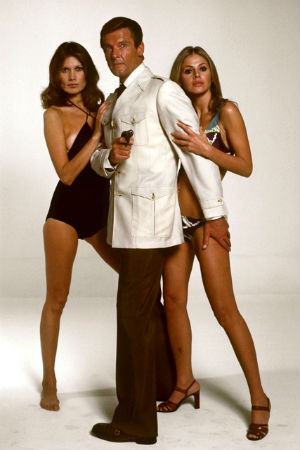 The best Bond movies are aware of their absurdities on a certain level — Bond is a serious character, but he’s cognizant of the fact that he’s often smack dab in the middle of nutty situations. Not so with The Man with the Golden Gun — in contrast to Lee’s fanged villainy as Scaramanga, Bond comes off as a trifle dull. Tanned and epicurean as always, Moore plays it surprisingly straight this time around, even when confronted with a villain with three nipples, or a homicidal midget. While he does well with the few one-liners he gets, most of the time he’s stuck in irritation mode. This has its payoffs — his tête–à–tête with Lee over an opulent lunch could be something out of Fleming, and features some of his finest acting of the series — but he tends to get lost amidst the shenanigans. His glumness infects other members of the cast: M (Bernard Lee) is in a foul a mood as we’ve ever seen him, and even Moneypenny (Lois Maxwell) shows exasperation with our hero for the first time. While Moore’s stiffness was mined for comedy in Live and Let Die, he has a lesser bunch of characters to bounce off of in Golden Gun: in addition to the aforementioned Nick Nack and J.W. Pepper, we have the dubious pleasure of Bond’s ditzy assistant Mary Goodnight (Britt Ekland), whose primary talents include getting thrown into a car boot, or accidentally setting off a solar-powered laser with her posterior.
The best Bond movies are aware of their absurdities on a certain level — Bond is a serious character, but he’s cognizant of the fact that he’s often smack dab in the middle of nutty situations. Not so with The Man with the Golden Gun — in contrast to Lee’s fanged villainy as Scaramanga, Bond comes off as a trifle dull. Tanned and epicurean as always, Moore plays it surprisingly straight this time around, even when confronted with a villain with three nipples, or a homicidal midget. While he does well with the few one-liners he gets, most of the time he’s stuck in irritation mode. This has its payoffs — his tête–à–tête with Lee over an opulent lunch could be something out of Fleming, and features some of his finest acting of the series — but he tends to get lost amidst the shenanigans. His glumness infects other members of the cast: M (Bernard Lee) is in a foul a mood as we’ve ever seen him, and even Moneypenny (Lois Maxwell) shows exasperation with our hero for the first time. While Moore’s stiffness was mined for comedy in Live and Let Die, he has a lesser bunch of characters to bounce off of in Golden Gun: in addition to the aforementioned Nick Nack and J.W. Pepper, we have the dubious pleasure of Bond’s ditzy assistant Mary Goodnight (Britt Ekland), whose primary talents include getting thrown into a car boot, or accidentally setting off a solar-powered laser with her posterior.
The Man with the Golden Gun might have been rescued if the action or nuttiness was ramped up, but the film finds the creative team at a low ebb. The Shane-like showdown for Bond and Scaramanga gets sidetracked by the solar energy plot, and their eventual duel in Scaramanga’s funhouse comes off as an afterthought. This is a Bond film made for more austere times, where we get a single hulking henchman overseeing the villain’s fortress instead of an army of toughs, where we get AMC autos instead of Aston Martins, where we get M bellowing at Q (Desmond Llewellyn) to shut up. Hamilton can’t find the right balance between jokiness and solemnity to buoy this material, and even Lulu’s title tune (she sang with a massive cold, and it shows) can’t supply the movie with a pulse.
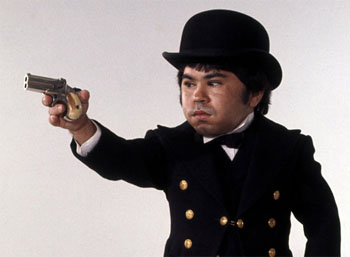 Golden Gun‘s below-par performance at the box office would mark a crucial crossroads in Bond film history. A scant five years after On Her Majesty’s Secret Service, 007’s future was once again very much in doubt. It would also be the end of Harry Saltzman as co-producer. The history books tend to gloss over his contributions to the series, but whatever one can say about his irascible behavior or sometimes questionable opinions (he thought Shirley Bassey’s Goldfinger title tune was a complete flop), he was a man of outrageous ideas and extravagant tastes, and those elements had become a key component of Bond’ s cinematic success. When Saltzman was forced to sell his share of the franchise to United Artists because of financial difficulties, the die was cast: for the next two decades, the fate of the Bond series would rest in the hands of Albert Broccoli and a studio that didn’t know how to get out of its own way (Heaven’s Gate or The Curse of the Pink Panther, anyone?). Three years would elapse between The Man with the Golden Gun and the next Bond opus, yet no one could have anticipated that the series was primed for one of its most improbable comebacks.
Golden Gun‘s below-par performance at the box office would mark a crucial crossroads in Bond film history. A scant five years after On Her Majesty’s Secret Service, 007’s future was once again very much in doubt. It would also be the end of Harry Saltzman as co-producer. The history books tend to gloss over his contributions to the series, but whatever one can say about his irascible behavior or sometimes questionable opinions (he thought Shirley Bassey’s Goldfinger title tune was a complete flop), he was a man of outrageous ideas and extravagant tastes, and those elements had become a key component of Bond’ s cinematic success. When Saltzman was forced to sell his share of the franchise to United Artists because of financial difficulties, the die was cast: for the next two decades, the fate of the Bond series would rest in the hands of Albert Broccoli and a studio that didn’t know how to get out of its own way (Heaven’s Gate or The Curse of the Pink Panther, anyone?). Three years would elapse between The Man with the Golden Gun and the next Bond opus, yet no one could have anticipated that the series was primed for one of its most improbable comebacks.
